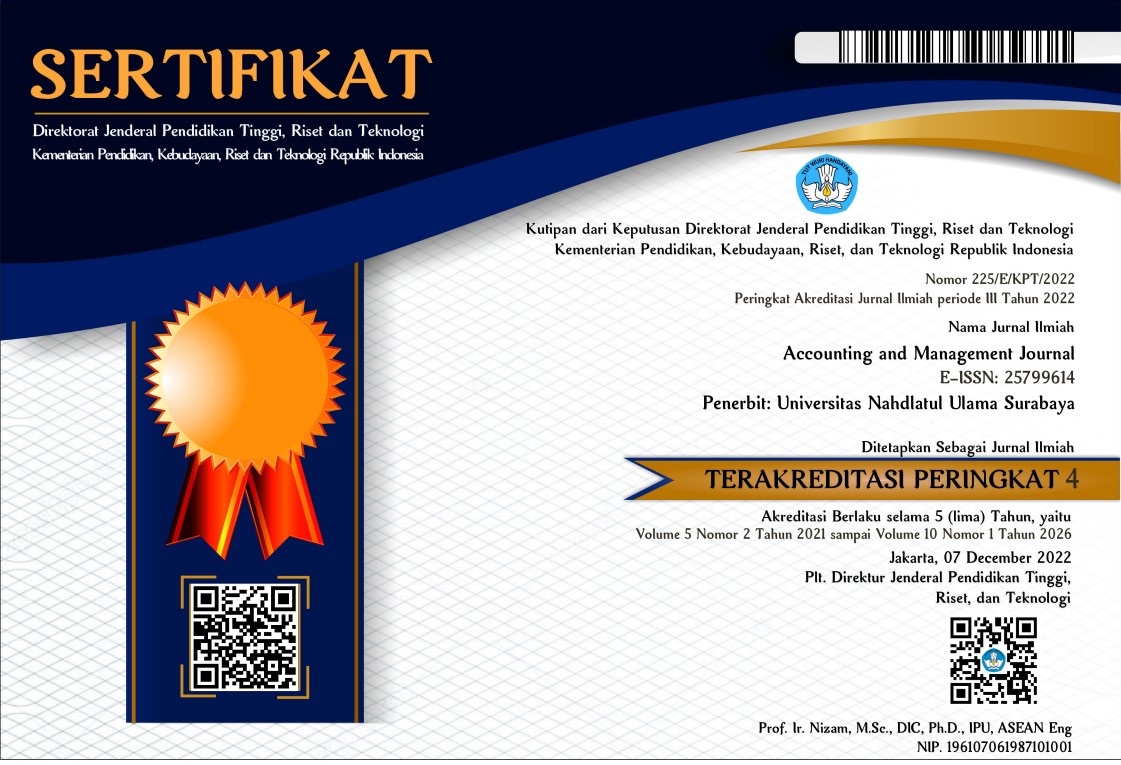PENCAPAIAN KINERJA PERUSAHAAN KELUARGA MELALUI TINGKAT KESIAPAN SUKSESOR DAN HUBUNGAN ANTAR ANGGOTA KELUARGA DAN BISNIS
DOI:
https://doi.org/10.33086/amj.v3i2.1412Keywords:
Family Business, Family Business Performance, Preparation Level of Heirs, Relation Among Family, Business MembersAbstract
Perusahaan keluarga merupakan salah satu penyumbang produk domestik bruto (PDB) terbesar di Indonesia. Universitas Ciputra memfasilitasi mahasiswa calon penerus perusahaan keluarga dengan membuat guild family business. Rencana suksesi dan komunikasi merupakan hal yang penting bagi perusahaan keluarga. Perusahaan keluarga harus mendidik suksesor yang potensial agar rencana suksesi dapat berlajan dengan baik. Tujuan penelitian ini adalah untuk menguji pengaruh tingkat kesiapan suksesor terhadap kinerja perusahaan keluarga; menguji pengaruh hubungan antar anggota keluarga dan bisnis terhadap kinerja perusahaan keluarga.
Penelitian ini menggunakan pendekatan kuantitatif. Populasi dalam penelitian ini adalah Family Business Community Universitas Ciputra dengan jumlah sampel yang berjumlah 93 orang, teknik pengambilan sampel yang digunakan dalam penelitian ini adalah purposive random sampling. Metode analisis data yang digunakan adalah Partial Least Square (PLS).
Hasil penelitian menunjukkan bahwa variabel Tingkat Kesiapan Suksesor berpengaruh positif dan signifikan terhadap Kinerja Perusahaan Keluarga; dan variabel Hubungan Antar Anggota Keluarga dan Bisnis berpengaruh positif dan signifikan terhadap Kinerja Perusahaan Keluarga.
Downloads
References
Aronoff, C. E., & Ward, J. L. (1995). Family-Owned Businesses: A Thing of the Past or a Model for the Future? Family Business Review, 8(2), 121–130. https://doi.org/10.1111/j.1741-6248.1995.00121.x
Bachkaniwala, D., Wright, M., & Ram, M. (2001). Succession in South Asian Family Businesses in the UK. International Small Business Journal: Researching Entrepreneurship, 19(4), 15–27. https://doi.org/10.1177/0266242601194001
Barach, J. A., & Ganitsky, J. B. (1995). Successful Succession in Family Business. Family Business Review, 8(2), 131–155. https://doi.org/10.1111/j.1741-6248.1995.00131.x
Bizri, R. (2016). Succession in the family business: drivers and pathways. International Journal of Entrepreneurial Behaviour and Research, 22(1), 133–154. https://doi.org/10.1108/IJEBR-01-2015-0020
Bozer, G., Levin, L., & Santora, J. C. (2017). Succession in family business: multi-source perspectives. Journal of Small Business and Enterprise Development, 24(4), 753–774. https://doi.org/10.1108/JSBED-10-2016-0163
Buang, N. A., Ganefri, & Sidek, S. (2013). Family business succession of SMEs and post-transition business performance. Asian Social Science, 9(12 SPL ISSUE), 79–92. https://doi.org/10.5539/ass.v9n12p79
Chin, W. W. (1998). The Partial Least Squares Aproach to Structural Equation Modeling. Modern Methods for Business Research. London.
Chu, W. (2011). Family ownership and firm performance: Influence of family management, family control, and firm size. Asia Pacific Journal of Management, 28(4), 833–851. https://doi.org/10.1007/s10490-009-9180-1
Diéguez-Soto, J., López-Delgado, P., & Rojo-Ramírez, A. (2015). Identifying and classifying family businesses. Review of Managerial Science, 9(3), 603–634. https://doi.org/10.1007/s11846-014-0128-6
Ghee, W. Y., Ibrahim, M. D., & Abdul-Halim, H. (2015). Family business succession planning: Unleashing the key factors of business performance. Asian Academy of Management Journal, 20(2), 103–126.
Kamei, K., & Dana, L. P. (2012). Examining the impact of new policy facilitating SME succession in Japan: from a viewpoint of risk management in family business. International Journal of Entrepreneurship and Small Business, 16(1), 60. https://doi.org/10.1504/IJESB.2012.046917
Kim, Y., & Gao, F. Y. (2013). Does family involvement increase business performance? Family-longevity goals’ moderating role in Chinese family firms. Journal of Business Research, 66(2), 265–274. https://doi.org/10.1016/j.jbusres.2012.08.018
Maciel, A. S., Ramos, M. I. de la G., Aguilar, J. L. E., & Reyna, J. M. S. M. (2015). The influence of family relationships in the succession: A factorial analysis of Mexican enterprises. Journal of Family Business Management, 5(2), 238–256.
Mokhber, M., Gi Gi, T., Abdul Rasid, S. Z., Vakilbashi, A., Mohd Zamil, N., & Woon Seng, Y. (2017). Succession planning and family business performance in SMEs. Journal of Management Development, 36(3), 330–347. https://doi.org/10.1108/JMD-12-2015-0171
Morris, M. H., Williams, R. W., & Nel, D. (1996). Factors influencing family business succession. International Journal of Entrepreneurial Behavior & Research, 2(3), 68–81. https://doi.org/10.1108/13552559610153261
Motwani, J., Levenburg, N. M., Schwarz, T. V., & Blankson, C. (2006). Succession planning in SMEs: An empirical analysis. International Small Business Journal, 24(5), 471–495. https://doi.org/10.1177/0266242606067270
Price Waterhouse Cooper. (2014). Survey Bisnis Keluarga 2014. (November), 1–35. Retrieved from https://www.pwc.com/id/en/publications/assets/indonesia-report-family-business-survey-2014.pdf
Pyromalis, V. D., & Vozikis, G. S. (2009). Mapping the successful succession process in family firms: Evidence from Greece. International Entrepreneurship and Management Journal, 5(4), 439–460. https://doi.org/10.1007/s11365-009-0118-3
Ramadani, V., Hisrich, R. D., Anggadwita, G., & Alamanda, D. T. (2017). Gender and succession planning: opportunities for females to lead Indonesian family businesses. International Journal of Gender and Entrepreneurship, 9(3), 229–251. https://doi.org/10.1108/IJGE-02-2017-0012
Setiawan, B. R., & Susanto, H. (2018). PERENCANAAN SUKSESI PADA PERUSAHAAN KELUARGA DI UNIVERSITAS CIPUTRA SURABAYA. Jurnal Manajemen Dan Start-Up Bisnis, 2(6), 690–696.
Venkatraman, N., & Ramanujam, V. (1986). Measurement of Business Performance in Strategy Research: A Comparison of Approaches. The Academy of Management Review, 11(4), 801. https://doi.org/10.2307/258398
Walsh, G. (2011). Family Business Succession. Managing the All Important Family Component. Kpmg Enterprise, 70.
Downloads
Published
How to Cite
Issue
Section
License
Copyright (c) 2019 Wahyudi Henky Soeparto

This work is licensed under a Creative Commons Attribution-ShareAlike 4.0 International License.












